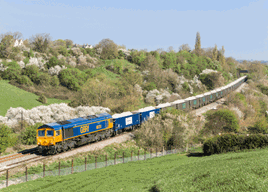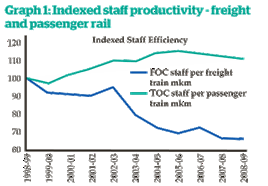 Read the peer reviews for this feature.
Read the peer reviews for this feature.
Download the graphs for this feature.
The past few weeks have been testing for the Chancellor, amid the House of Lords rebellion and subsequent tax credit defeat. Nevertheless, he reasserted his budget surplus pledge at Imperial College’s White City campus on November 9, announcing that four Government departments had agreed to 30% spending cuts over the course of this Parliament. Being an unprotected department, and given previous speculation, it came as no surprise that the Department for Transport would be one of these four.
Many from the rail industry were concerned that Network Rail’s capital expenditure would be dragged into these deals. Thankfully, Osborne showcased his commitment to UK infrastructure growth, stating: “These provisional settlements apply to the day-to-day resource spending of the central departments - they are not the capital budgets of these departments.”
The industry is now left awaiting the final outcomes of the three Network Rail reviews by Sir Peter Hendy, Dame Colette Bowe and Nicola Shaw. The Hendy assessment of the CP5 upgrade programme has drawn the most attention (for obvious reasons), as it tackles which programmes and projects are possible in this Control Period.
If the Government is to stick with its productivity plan commitments and combat taxpayer attacks on electrification schemes (as I believe it will), the focus will be on ensuring the continuation of those upgrades that benefit passengers, rather than freight. This is somewhat inevitable, given that ‘freight can’t vote’. But the lack of attention also stems from another source - a lack of understanding and experience of the economic realities of the rail freight industry.
Harsh realities of rail freight
Advisors, consultants and political figures all seem to have opinions about rail freight… what it does, what it can do, and what its challenges are. However, many don’t understand the harsh realities and foundations that underpin rail freight’s existence.
We are an industry with high fixed costs over lengthy timescales. Locomotives and wagons are leased for five- to ten-year periods. People and the systems that manage them are also difficult to reduce at short notice. In consequence, the revenues needed to support such costs require the efficient haulage of high-volume or high-tonnage cargoes. If you’re hauling empty wagons, you’re likely suffering.
This is why I’ve often argued that parcels on rail isn’t adaptable to rail freight economics. Setting aside the investments needed in station facilities, as well as regulatory incentives, the requirement for large volumes doesn’t suit the market. The best that can be hoped for is a small amount of traffic on existing passenger services, although the desperate need for space for people negates the likelihood of this happening.
The success of privatisation
This need for high volumes or tonnage has best been served by privatisation. The competitive environment has allowed us to increase total volume haulage by over 80% since the 1990s and to become more efficient, returning value to customers. A 2015 Rail Delivery Group report states that “train numbers have fallen by 30% since 2003, yet freight tonnes lifted has increased by 30%, resulting in an increase in tonnes per train of over 80%”.
Increased productivity and private investment have been key determinants to this success. McNulty’s 2011 report, Realising the Potential of GB Rail, showed the clear contrast in staff productivity between the freight sector and the more centrally controlled passenger sector since 1998, with freight experiencing a 32% improvement and passenger experiencing a considerable decline (see graph 1).
Since privatisation there has been significant investment of over £2.5 billion from rail freight operators across the industry. At GB Railfreight, we have dramatically increased our locomotive and wagon fleet since I created the company in 1999. Our £60 million investment in 21 Class 66s and 16 Class 92s last year is testament to this. We now possess a fleet of 120 locomotives and more than 1,100 wagons, operating over 1,000 trainloads per week as of this year.
However, despite growth in operations and efficiency, it’s important to remember that the market can only take rail freight so far. On top of requiring high volume or tonnage, our existence ultimately depends on the commodity markets we serve and the network capacity available. This leads me on to the challenge the industry now faces.












